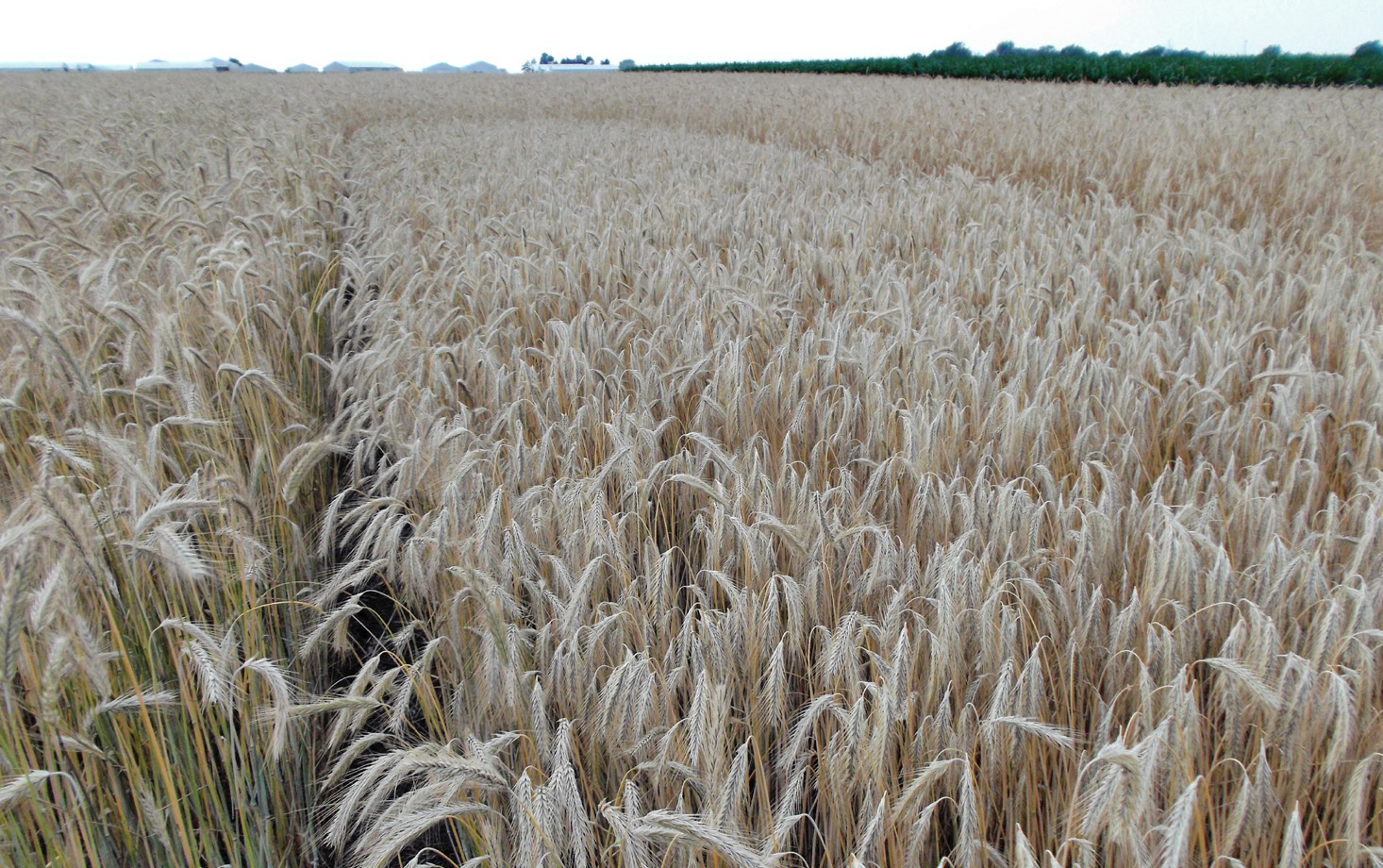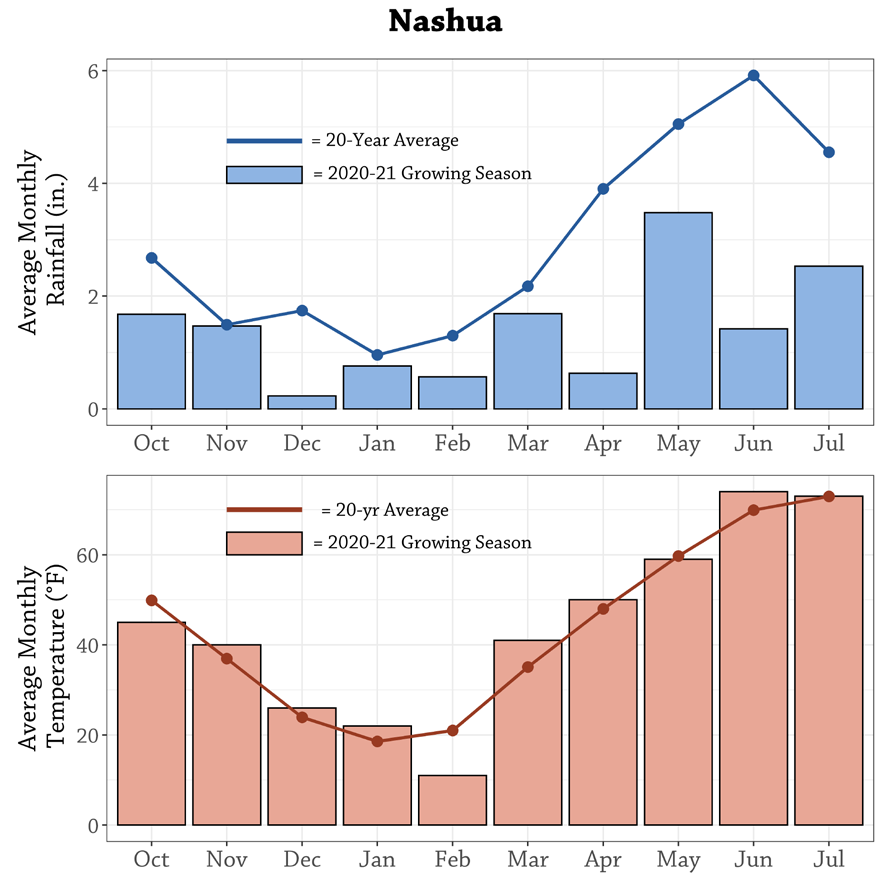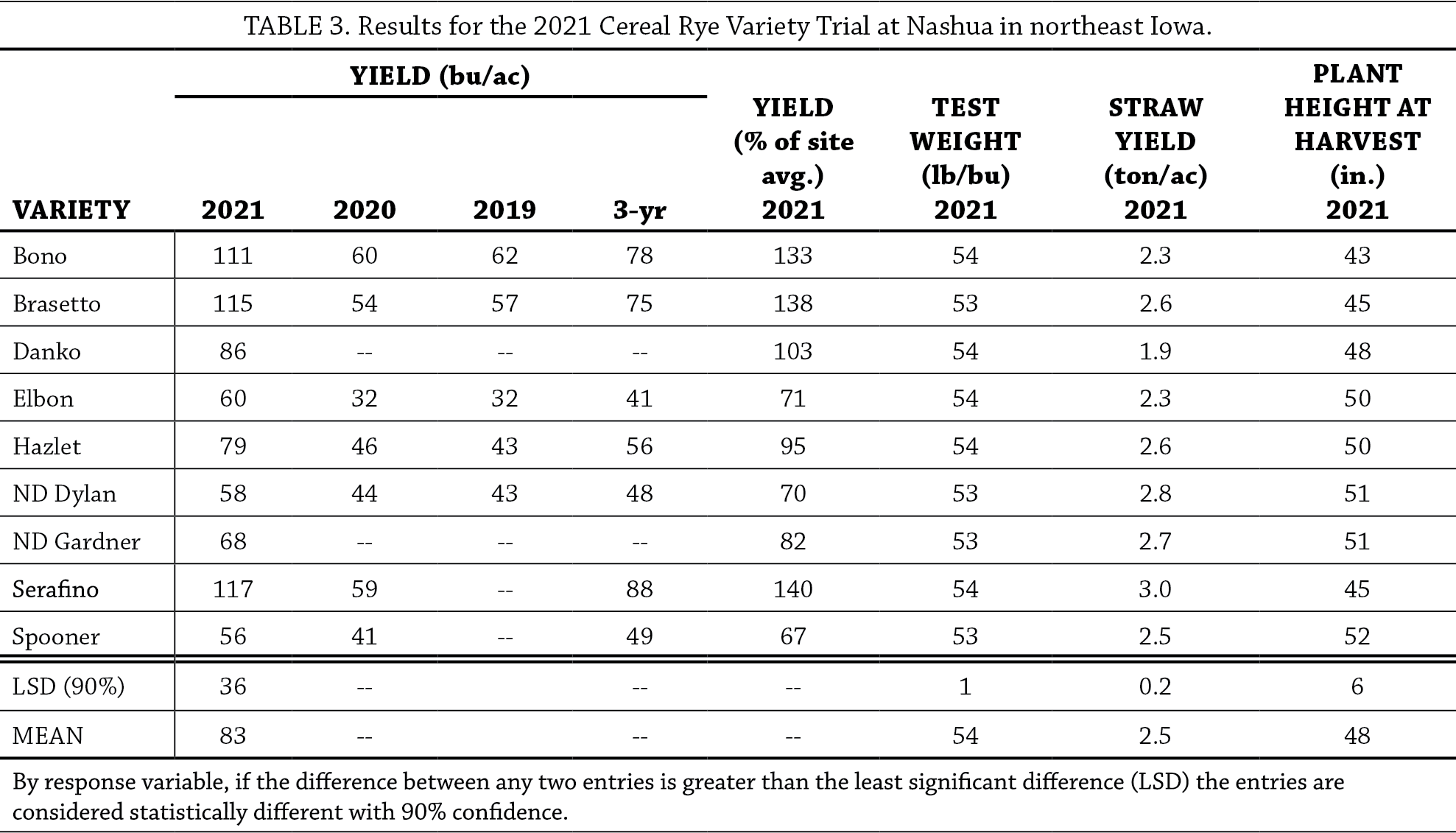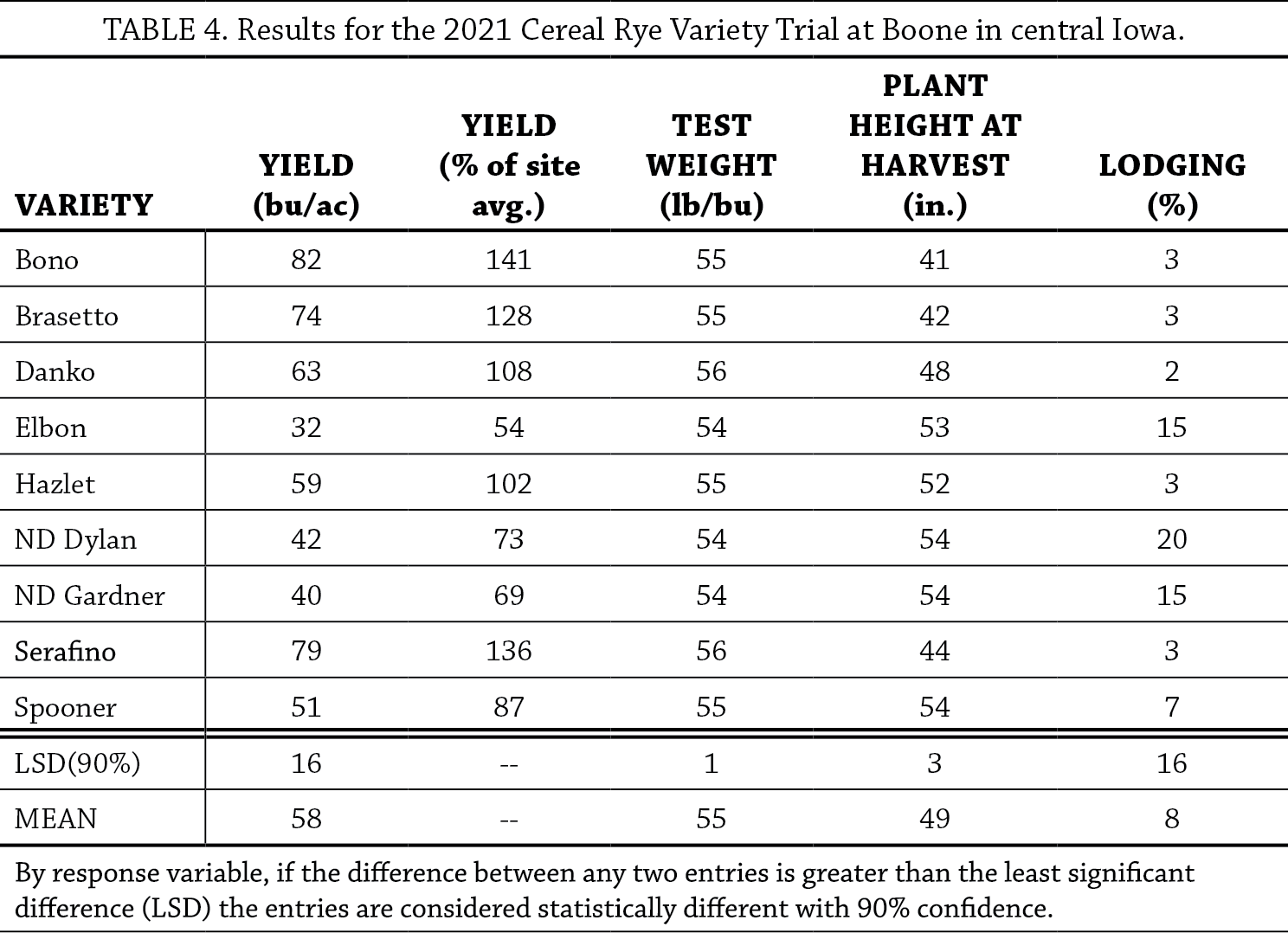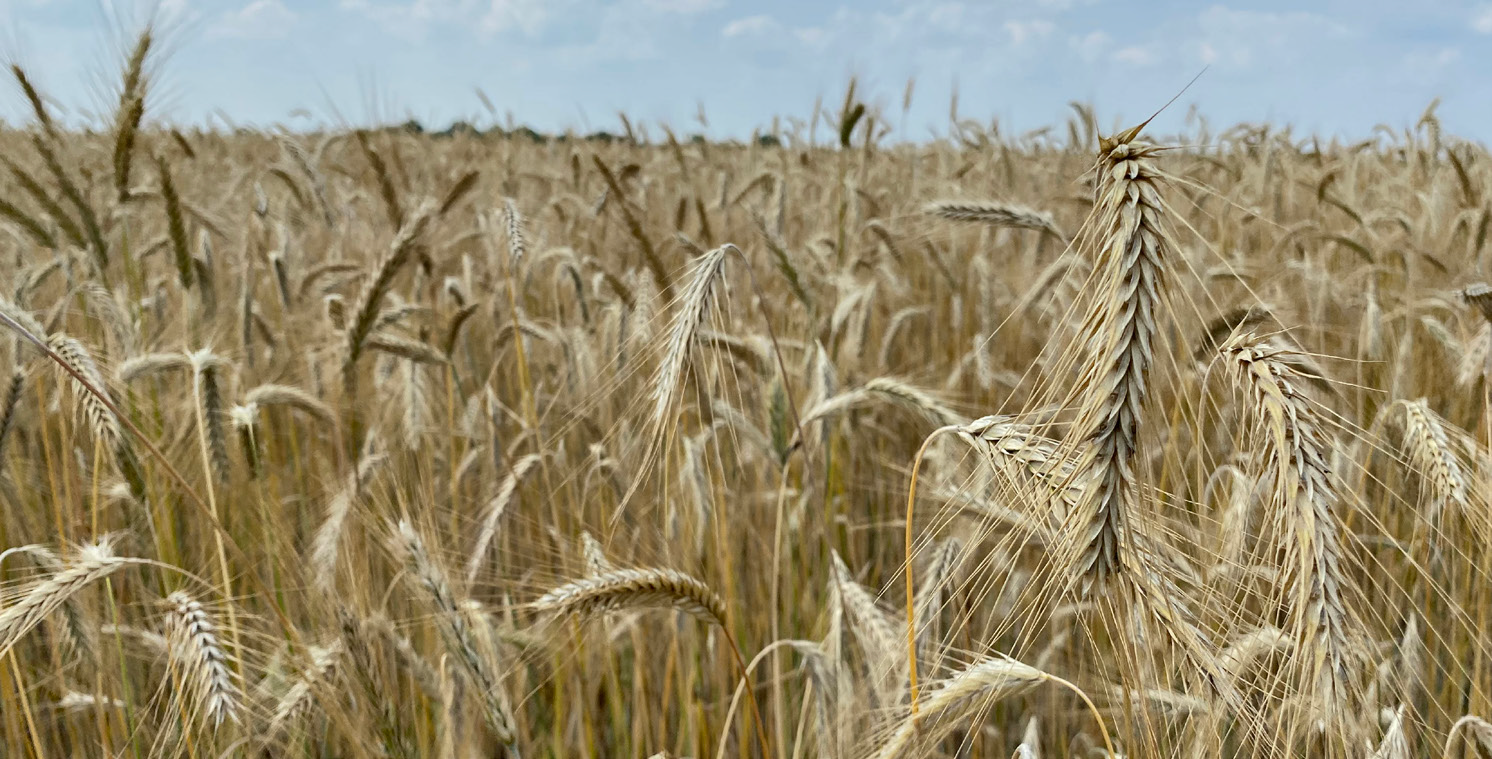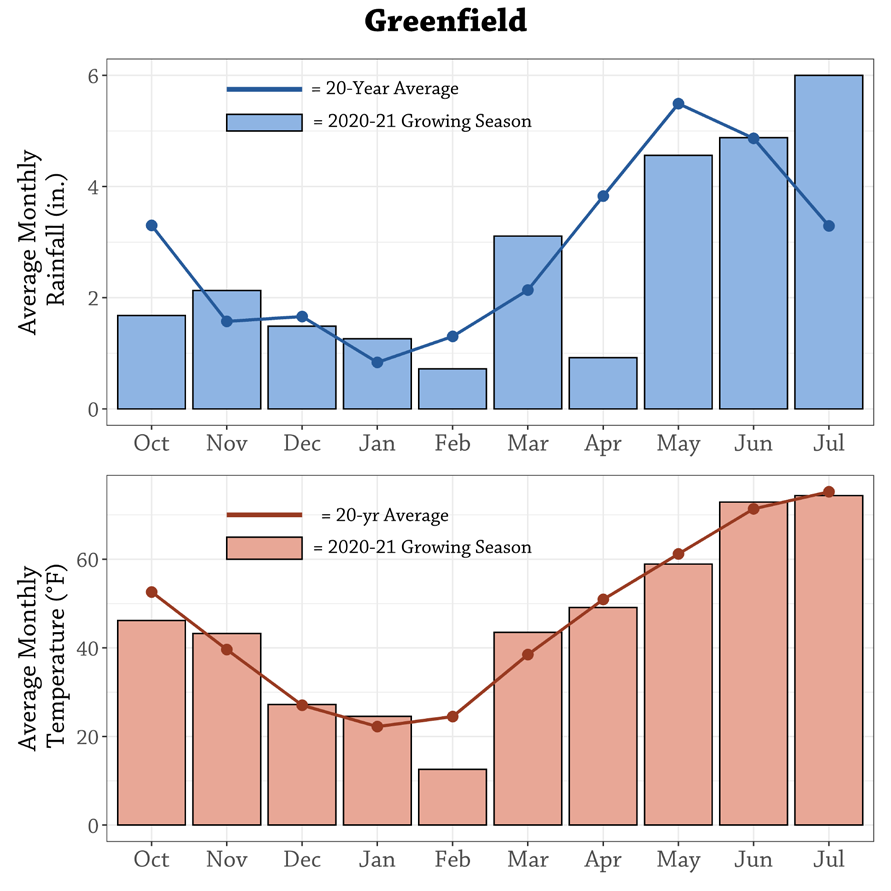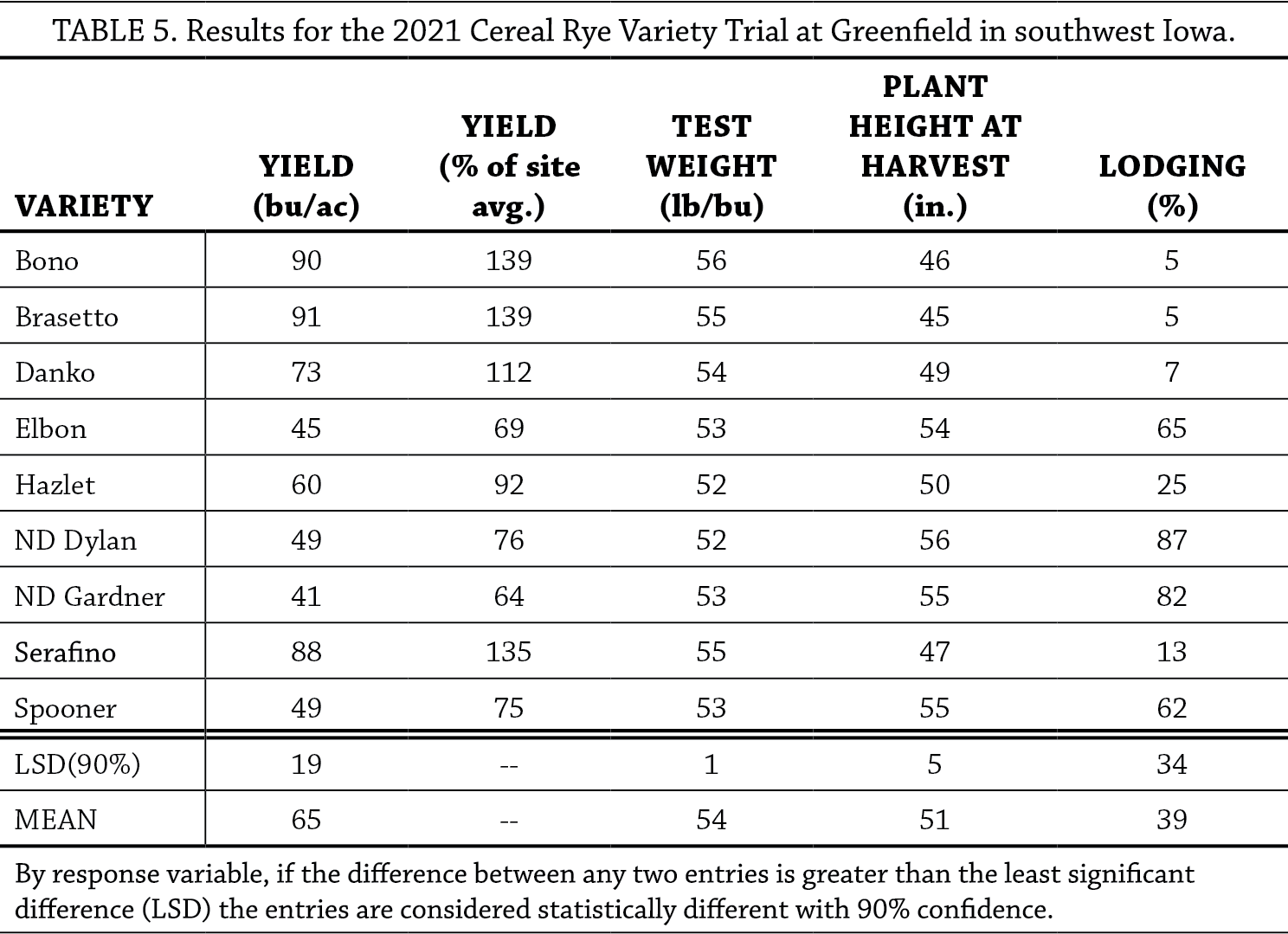This research was funded by Walton Family Foundation and Albert Lea Seed House
In a Nutshell
- Nine cereal rye varieties were screened at four Iowa State University research farms.
Key Findings:
- Across sites and varieties, average cereal rye yield was 65.3 bu/ac.
- Hybrid varieties, Bono, Brasetto and Serafino, were the top-yielding varieties at each site. Hazlet and Danko were the top yielding open-pollinated varieties at each site.
- Across all sites and open-pollinated varieties, average germination was 91%.
Background
Cereal rye, otherwise known as winter rye, is the hardiest of the small grains, germinating at temperatures as low as 35 °F in the fall before going into winter dormancy and resuming growth in the early spring. Because of its hardiness, cereal rye has become a staple winter cover crop in corn-soybeans production systems. Subsequently, demand for cereal rye cover crop seed is increasing, although cereal rye can also be marketed for milling and animal feed. Harvesting cereal rye for grain occurs in mid- to late July, spreading labor and leaving farmers with the opportunity to establish a summer cover crop or apply mid-season manure. Currently most cereal rye planted as cover crop in Iowa is VNS (“Variety Not Stated”). However, farmers looking to plant cereal rye for grain, straw, forage or to roller-crimp their cover crop should consider planting named varieties as they can deliver higher performance and uniformity.
This was the third year that Practical Farmers of Iowa coordinated cereal rye variety trials. In 2021, all trials were moved to Iowa State University research farms. In 2019, the average cereal rye yield across three sites in northern Iowa was 43 bu/ac.[1] In 2020, the average cereal rye yield across the same northern Iowa sites was 39 bu/ac.[2] Cereal rye variety trials conducted by the University of Minnesota reported an average yield of 85.8 in 2020.[3]
Methods
Variety trials were conducted at four locations in 2021: ISU Northern Research Farm in Kanawha; ISU Northeast Research Farm in Nashua; ISU Ag Engineering and Agronomy Farm in Boone; ISU Southwest Research Farm in Greenfield. Production characteristics and some breeding history about each of the trialed varieties can be found in Table 1. Information on winter hardiness, days to heading, plant height and ergot susceptibility was sourced from the University of Minnesota.[3]
Rye management information is provided with the results from each location. No herbicide, insecticide or fungicide were applied at any location. Data were analyzed using JMP Pro 15 (SAS Institute Inc., Cary, NC). Statistical significance is determined at P ≤ 0.10 level and means separations are reported using Tukey’s least significant difference (LSD).
Rye seed samples from each location were sent to the Iowa State Seed Testing Laboratory for germination testing roughly five weeks after harvest. Samples were pooled across replicates at each site and this precluded us from analyzing these germination data statistically. As such, please keep in mind: We present germination percentages in this report as a rough comparison among varieties and locations.
Results and Discussions
Data were analyzed by location and reported yields are corrected for 14% moisture. A “percentage of test average” calculation for 2021 is included to aid in comparing among entries at each location. The yield average is provided for varieties that were also trialed in 2019 and 2020 at Nashua and Kanawha. Rainfall and temperature data were accessed from the nearest weather station.[4] Rainfall was lower than average for the 2020-2021 growing season, especially at the Nashua and Boone research farms.
Across all sites and varieties, the average yield was 65.3, higher than both the 2019 and 2020 averages. Bono, Brasetto and Serafino, all hybrid varieties developed by KWS, were the top yield performers at each location, having yields of roughly 10-30 bu/ac higher than the open-pollinated varieties. The hybrids were also shorter in stature than the open-pollinated varieties (sometimes by as much as 8-10 in.). Of the six open-pollinated varieties trialed, Danko and Hazlet were the top yielding varieties across all four sites.
Varieties at the Greenfield farm had the highest percent lodging (Table 5), however they were also harvested the latest, two weeks after the varieties were harvested at Nashua, which had the highest yields of all sites (Table 3).
Seed germination ranged from 62 to 98% (Table 6). Samples with low germination were reported to have fungal abnormalities present. Boone and Kanawha had, on average, higher germination across varieties than Greenfield and Nashua.
ISU Northern Research Farm, Kanawha
- Previous crop: Soybeans
- Replications: 3
- Harvested plot size: 5 ft x 60 ft
- Fertilizer applied: 28 lb N/ac and 147 lb P/ac on November 3, 2020 and 36 lb N/ac and 192 lb Gypsum/ac on April 6, 2021
- Planting date: October 7, 2020
- Row Spacing: 7.5 in.
- Seeding rate: 23 seeds/ft2 – see Table 1 for pounds per acre of each variety to reach target population
- Seeding depth: 1.25 in.
- Harvest date: July 19th, 2021
ISU Northeast Research Farm, Nashua
- Previous crop: Soybeans
- Replications: 3
- Harvested plot size: 8 ft x 50 ft
- Fertilizer applied: 60 lb P/ac and 267 lb K/ac on October 21, 2020 and 30 lb N/ac on March 3, 2021
- Planting date: October 9, 2020 with no-till drill followed by cultipacker
- Row spacing: 7.5 in.
- Seeding rate: 23 seeds/ft2 – see Table 1 for pounds per acre of each variety to reach target population
- Seeding depth: 1.25 in.
- Harvest date: July 13, 2021
ISU Ag Engineering and Agronomy Farm, Boone
- Previous crop: Soybeans
- Replications: 3
- Harvested plot size: 5 ft x 60 ft
- Fertilizer applied: 30 lb N/ac, 100 lb P/ac, 25 lb S/ac on April 3, 2021
- Planting date: October 7, 2021
- Row spacing: 7.5 in.
- Seeding rate: 23 seeds/ft2 – see Table 1 for pounds per acre of each variety to reach target population
- Seeding depth: 1.25 in.
- Harvest date: July 22, 2021
ISU Southwest Research Farm, Greenfield
- Previous crop: Soybeans
- Replications: 3
- Harvested plot size: 5 ft x 56 ft
- Fertilizer applied: 14 lb N/ac on April 7, 2021 and 37 lb N/ac, 175 lb P/ac and 164 lb K/ac on April 15, 2021
- Planting date: October 7, 2020
- Row spacing: 7.5 in
- Seeding rate: 23 seeds/ft2 – see Table 1 for pounds per acre of each variety to reach target population
- Seeding depth: 1.25 in.
- Harvest date: July 28, 2021
Conclusions and Next Steps
Desired cereal rye characteristics vary depending on intended purpose of the crop. For instance, hybrid rye is the best option for those using cereal rye for milling or livestock feed, as it has the highest yield. However, hybrid rye cannot be saved for seed, therefore those interested in the cover crop seed market must choose an open-pollinated variety. For those looking to roller crimp, using ND Gardner, an early, tall variety is best. Germination results were high across all sites and varieties, except in cases where seed showed signs of fungal disease, underscoring the importance of proper disease management for cover crop seed. Farmers intending to sell cereal rye seed for cover crops to be sold off their farm need to be familiar with intellectual property considerations and the licensing process for those varieties with plant variety protection.
With the compiled information on plant protection status, winter hardiness, days to heading, plant height, and ergot susceptibility, alongside the researched characteristics of yield, test weight, plant height, and % percent lodging, a farmer in Iowa can determine which cereal rye variety will best meet their production goals.
References
- Gailans, S. 2019. Cereal Rye Variety Trial 2019. Practical Farmers of Iowa Cooperators’ Program. https://practicalfarmers.org/research/cereal-rye-variety-trial-2019/ (accessed September 2021).
- Gailans, S. and L. English. 2020. Cereal Rye Variety Trial 2020. Practical Farmers of Iowa Cooperators’ Program. https://practicalfarmers.org/research/cereal-rye-variety-trial-2020/ (Accessed September 2021)
- Wiersma, J., S. Wells, and A. Garcia y Garcia. 2020. 2020 Winter Rye Field Crop Trials Results. University of Minnesota. https://indd.adobe.com/view/94992f09-a529-41d3-8703-941d4b829926 (accessed September 2021).
- Iowa Environmental Mesonet. 2021. Climodat Reports. Iowa State University. http://mesonet.agron.iastate.edu/climodat/ (accessed September 2021).


